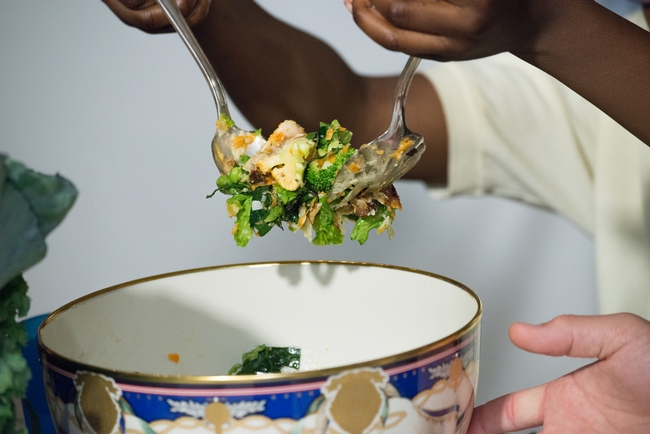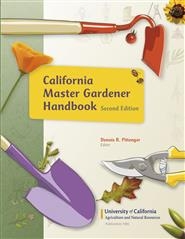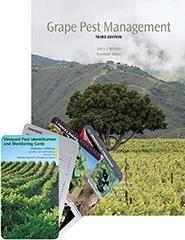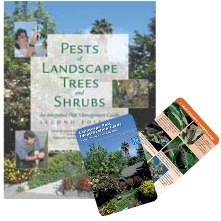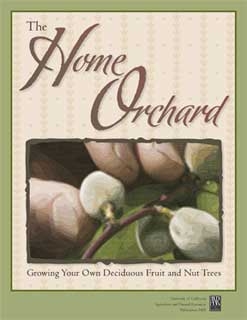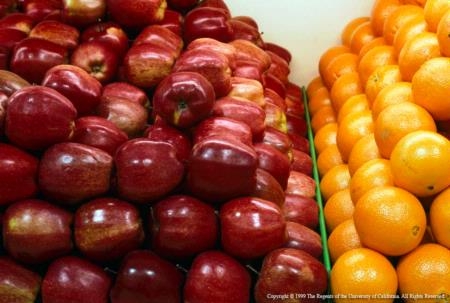Posts Tagged: holidays
Best wishes for holidays filled with joy, and free of debt and injury
The end-of-year holidays are a perfect time to enjoy family, gifts and food. It's time to laugh, relax, cook and eat the most delicious meals of the year.
Unfortunately, it can also be a time when excess can put your health and finances at risk, leaving you to begin the New Year with debt, stress and anxiety.
Experts with UC Cooperative Extension have practical advice to make the festivities joyful and worry-free. They also provide some simple guidelines to select toys for children with maximum fun and minimum heartache.
Don't go into debt
Shopping is a temptation all year, but during the holidays even conservative shoppers can be seduced into spending too much. In the United States, the average shopper will spend $885 on gifts, according to Gallup.com. For that spending, UCCE experts recommend shoppers avoid making purchases on credit.
Patti Wooten Swanson, UCCE nutrition, family and consumer sciences advisor in San Diego County, believes using a credit cards encourages over spending. Before you know it, the debt will begin to acquire interest, the interest continues to grow, and the purchases become substantially more expensive.
She suggests shoppers establish a budget, think of the people you would like to give gifts, and determine the amount of cash available for each of them before heading to the store.
“Organizing the expenses is very important for people at all income levels to learn to manage money, reach financial security and use their economic resources to acquire what is really important for you and your children,” Wooten Swanson said.
Following are recommendations for using a credit card:
- Don't use a credit card to make a purchase if you don't have the funds to pay it off at that moment.
- Understand that the actual cost of interest can vary greatly, from zero percent for a limited time up to 30 percent. Pay all charges at the end of the month to avoid paying interest.
- Avoid paying only the minimum payment on your credit card, as creditors may then consider you “high risk” and increase your interest rate.
- An advantage of paying with a credit card is the security of not having to take cash with you shopping.
Remember, spreading holiday cheer doesn't require spending a lot of money. There are also treasured gifts, such as those that are homemade, that will persist in the recipient's memory because they come from the heart.
Eat everything, but in moderation
The holidays hail the arrival of many rich dishes, such as tamales, roasted meats and an array of chocolates, cookies and desserts. Many of these foods require a great deal of preparation and are only available at this time of year, increasing the temptation to eat them. But, they often contain a significant amount of salt, sugar and fat.
“Everybody knows we eat because we have to nourish our bodies, but we also eat for pleasure, to socialize or because we enjoy the flavors of the foods,” said Lorrene Ritchie, director of the UC Agriculture and Natural Resources' Nutrition Policy Institute. “Sometimes what we like eating isn't the most healthy, and it's important to know that you don't have to feel guilty and renounce all foods that are unhealthy. Just be sure that most of the time you and your children opt for healthy foods.”
Following are a few suggestions from UC ANR experts can make the holiday eating and playing healthier and safer.
Drink water
During the festivities, we can allow ourselves to enjoy a sugary drink now and then, but always drink water to quench thirst.
“To work off one can of soda, you'll have to walk a few hours. Calories don't burn off very rapidly with physical activity,” Ritchie said.
Salads at your parties
Salads are very healthy, and the more colorful, the better. Each vegetable of a different color contains different nutrients.
“Latinos love fruit. I believe we eat enough fruits,” said Margarita Ramirez Schwartz, UC Cooperative Extension nutrition educator in San Diego County. “But we don't consume as much vegetables, and above all, raw salads.”
At your parties, always serve salads. If you don't have time for salad preparation, opt for convenience products like packaged vegetables and greens that are pre-washed, pre-cut and ready to serve.
Dance
A family dance creates timeless memories. There is no grandparent that can decline when a granddaughter wants to dance. Among Latinos, dancing is part of the culture. Be it salsa, samba, huapango or merengue, any rhythm will help you stop eating, have fun and improve your health.
“The key is to realize that exercise is as important for your health as eating and sleeping,” Ramirez-Schwarz said. “We all want to live for many years, and spend those years enjoying good health. No one likes to be sick and physical activity is part of illness prevention.”
Toys
The joy of Christmas and Epiphany for children often takes the form of new toys, which entertain and spark imagination and creativity. Parents want their children to be happy and have the opportunity to learn by playing with safe toys. Alas, it doesn't always work out this way.
In 2016, there were 240,000 injuries related to toys, according to the Consumer Product Safety Commission. Toys usually appear harmless, but children with injuries caused by toys arrive at hospitals every year. WATCH (World Against Toys Causing Harm, Inc.) is a non-profit organization that monitors toy safety and compiles a list of harmful toys. For example, the leash on a wooden dog can cause strangulation. The lighted eyes that detach easily from a stuffed unicorn can choke a youngster. A toy rifle that shoots plastic disks can hit another child in the eye.
UC ANR experts recommend that you choose toys that will hold a child's interest, taking into account the child's age, fine motor skills and preferences. A toy that is too advanced or too simple could be used in the wrong manner and cause accidents. Think big when choosing toys. Each small piece must be larger than the child's mouth to prevent harm.
- Carefully examine the toys made of painted metal. There are some made overseas that can contain high levels of lead.
- Make sure the toy doesn't have small parts on which a child can choke or that can put younger children in the household at risk.
- Avoid toys that are old and used because they may not comply with current security rules or they may be worn out, break easily and be a danger to children.
- Look for toys with a solid structure. You do not want to give a toy to children that can break easily.
- To prevent cuts, check to be sure the toy doesn't have sharp points or edges.
- Avoid toys that make a lot of noise that could damage the child's hearing.
- Be sure activity books and art supplies are nontoxic.
- Give the toy with batteries, if needed, so that the children won't be frustrated when they receive the gift.
Finally, remember that there is no better gift to children than your time. The toy will be forgotten shortly, but the time that children spend with their families will create life-long memories.
Read the Spanish version of this story.
Nine great gifts for your farmer or gardener this holiday season
Struggling to find that perfect gift for your agriculture expert or gardening guru this year? Well, look no further! We've assembled a great list of books and bundles on sale for you this Holiday Season! Backyard gardening, vineyard management, weed and pest identification, we have it all! All of our ebooks are on sale right now for only $9.99 as well. Give the gift of farm and garden knowledge this season!
But act quickly, these deals are going dormant on December 19!
Save 30% — the lowest price ever offered on our definitive guide to gardening in California! Whether for the serious gardener on your list or yourself, this handbook will be your go-to source for the practical, science-based information you need to sustainably maintain your landscape and garden and become an effective problem solver.
Chapters cover soil, fertilizer, and water management, plant propagation, plant physiology; weeds and pests; home vegetable gardening; specific garden crops including grapes, berries temperate fruits and nuts, citrus, and avocados. Also included is information on lawns, woody landscape plants, landscape design, information on invasive plants and principles of designing and maintaining landscapes for fire protection.
$37.00 now $25.90
Keep your vineyard healthy by staying on top of pests with this bundle and save 30%!
The 3rd edition of Grape Pest Management is a comprehensive, easy-to-read pest management tool; pair it with the pack of 50 sturdy, pocket-size laminated Vineyard Pest ID Cards and you're well equipped to identify and manage most common problems.
The new edition of Grape Pest Management includes several new invasive species that are now major pests. Nine expansive chapters and helpful, colorful photos throughout. The Vineyard Pest ID cards cover 41 common insects and mites, 11 diseases, 23 beneficial insects, and a variety of other disorders, weeds, and invertebrate pests. Each pest is identified by a description and close-up color photographs—244 photos in all. On the reverse of each card is a description of the various life stages and monitoring tips.
$125.00 now $87.50
This beautifully illustrated book is a "must-have" for the grower, vintner, or wine enthusiast on your list. Inside you'll find information on ripening periods for 53 varieties, ripening dates of varieties by period and growing district, detailed illustrations of grapevine structure, a glossary, and a bibliography. Each variety is highlighted by close-up photography of clusters, leaves, and leaf shoots--107 lush color photos in all.
$30.00 now $21.00
With this combo in hand you will be able to diagnose and manage hundreds of insect, mite, weed, plant disease, and nematode pests.
Inside Pests of Landscape Trees and Shrubs, you'll find valuable information on how to use environmentally safe, ecologically based IPM methods; landscape designs that prevent pests; how to select resistant varieties; advice on the use of less-toxic pesticides such as botanicals, oils, and soaps; and tips on planting, irrigating, and other plant-care cultural activities that help in avoiding problems.
The Landscape Pest ID Cards can be easily carried with you as a quick reference wherever you need them. Covers 80 common insects and mites, 40 diseases, 20 beneficial insects, and a variety of other disorders and invertebrate pests. Each pest is identified by a description and excellent close-up color photographs of important symptoms and life stages - 211 photos in all.
$55.00 now $38.50
Save over 25% when you order the bundle including the Weed Pest ID Cards and the two volume Weeds of California and Other Western States . When purchased individually these two items are $125.00 - buy the bundle and save!
The easy-to-use 2-volume set covers 262 individual entries, and includes color photos of over 700 seeds, seedlings, flowers, and mature plants; handy identification tables; grass identification keys; and a CD containing over 3000 presentation ready photos from the book. The pocket-sized companion cards cover 48 of the most common weeds, grouped into 8 categories for easy identification held together with a sturdy rivet.
$105.00 now $75.00
Is there a backyard orchardist on your list? The Home Orchard offers an insider's look at both standard growing methods and unique innovative practices. Includes info on which species grow best in different regions and soils and how to select a variety for your region. Step-by-step information from soil preparation and planting to watering and fertilizing; pruning and grafting to thinning pest control, and harvesting.
Irrigation methods for the backyard grower are discussed and the difficult task of how often and how much water to apply is simplified.
$25.00 now $18.75
Here's your chance to scoop up the lowest price we've ever offered on this encyclopedic, yet easy-to-use 2-volume set! It c overs 262 individual entries, including a full description of 451 species and another 361 plants compared as similar species, representing 63 plant families.
Each entry describes the plant category, family name, common name, and synonyms along with a summary of the important aspects of the plant's life cycle, size, growth form, impact, method of introduction, and toxicity. You'll also find a description of the seedling, mature plant, roots and underground structures, flowers, fruits and seeds, spikelets and florets, spore-bearing structures, and post senescence characteristics for each entry.
This set also includes a CD with over 3000 photographs from the book! Perfect for use in PowerPoint presentations!
$80.00 now $56.00
Save 30% off the combined cover price of $70.00 when you purchase Pests of Landscape Trees and Shrubs and Abiotic Disorders: A Diagnostic Guide!
Pests of Landscape Trees and Shrubswill help you diagnose and manage hundreds of insect, mite, weed, plant disease, and nematode pests. You'll find valuable information on how to use environmentally safe, ecologically based IPM methods; landscape designs that prevent pests; how to select resistant varieties; advice on the use of less-toxic pesticides such as botanicals, oils, and soaps; and tips on planting, irrigating, and other plant-care cultural activities that help in avoiding problems.
Abiotic Disorders of Landscape Plants contains a wealth of information to help you diagnose disorders caused by environmental, physiological or other non-biological factors. You'll learn how to diagnose injury symptoms from a wide-ranging list of abiotic disorders including water deficit, nutrient deficiencies, salinity, pH, sunburn, herbicide, mechanical injuries, lightning, wind, and hail. You'll also learn how to develop a step-by-step diagnostic strategy.
$70.00 now $49.00
-
All of our Ebooks are $9.99 and under!
All of our Kindle books and Epubs are on sale for $9.99 or cheaper right now! Take advantage of this opportunity and fill up your digital library!
Click here for a list of all of our Kindle (MOBI) books.
Click here for a list of all of our Epub books.
To see all of our publications, visit: anrcatalog.ucanr.edu
Looking back at your leftovers
In order to keep the holidays from being spoiled, here are a few tips and tools to have at your disposal. First, check out the food storage chart to know the storage times for your food goodies. For example, cooked poultry has a shelf life of 3 to 4 days in the refrigerator, but can be extended to 2 to 6 months in the freezer. When reheating leftovers in the microwave, remember to bring them to a temperature of 165 degrees F.
If you struggle to remember how old your leftovers are, you are not alone. While lifespan varies, generally there is a four-day guideline. You can use an easy labeling system or even search for food storage phone apps to aid your memory. Iowa State University Extension mentions the 4 Day Throw away app as one possibility.
If both refrigerator and freezer space is now completely taken, but you still want to make some holiday gifts, consider dehydrating, pickling, and canning. Some fall/holiday ideas include:
- Dehydrated fruits – colorful, healthy and space saving
- Pie filling – a perfect gift for busy friends or family
- Fall Garden Relish (recipe below from So Easy to Preserve, sixth edition)
- Lemon curd – sweet, sour, rich, and buttery all at once. Yum!
Fall Garden Relish
Recipe from the National Center for Home Food Preservation
(Yields about four pint jars.)
1 quart chopped cabbage (about 1 small head)
3 cups chopped cauliflower (about 1 medium head)
2 cups chopped green tomatoes (about 4 medium)
2 cups chopped onions
2 cups chopped sweet green peppers (about 4 medium)
1 cup chopped sweet red peppers (about 2 medium)
3 ¾ cups vinegar (5%)
3 tablespoons canning salt
2 ¾ cups sugar
3 teaspoons celery seed
3 teaspoons dry mustard
1 ½ teaspoon turmeric
Combine chopped vegetables; sprinkle with the 3 tablespoons salt. Let stand 4 to 6 hours in a cool place. Drain well. Combine vinegar, sugar and spices; simmer 10 minutes. Add vegetables; simmer 10 minutes. Bring to a boil.
Pack boiling hot relish into hot jars, leaving 1/2-inch headspace. Remove air bubbles. Wipe jar rims. Adjust lids. Process 10 minutes in a boiling water bath.
If you've never preserved before, consider attending public classes held by UC Master Food Preserver Programs around the state. Find your program and get started!
Six tips to make gift cards a great present
For the eighth year in a row, the most popular item on holiday wish lists is gift cards. According to a National Retail Federation Survey, 62 percent of those celebrating Christmas, Kwanzaa or Hanukkah in 2014 said gift cards are their most-requested gifts, trumping clothing, books, CDs, DVDs, video games and electronics.
“In the past, gift cards may not have seemed like a very thoughtful gesture,” said Patti Wooten Swanson, consumer sciences advisor with UC Cooperative Extension in San Diego County. “But today, it's what people want.”
Swanson has a Ph.D. in consumer science from Texas Women's University in Denton, Texas. She is the author of a seven-part series of financial caregiving publications and is co-chair of the UC Division of Agriculture and Natural Resources Money Talks workgroup, which created a Money Talks website that helps teenagers learn to manage their finances.
Swanson said gift cards are a particularly good deal for retailers. They get the money, and don't have to part with the merchandise until the card is redeemed, if ever. A survey by Consumer Reports found that 10 percent of gift card value typically goes unused. The magazine suggests cash or a check are great alternatives, but Swanson says she still often opts for gift cards.
“Cash can tend to be used for everyday things,” Swanson said. “If I want my dad to enjoy a meal at his favorite restaurant, I would still give a gift card.”
Swanson offers the following suggestions for ensuring successful gift card experiences:
- If you receive a gift card, use it as quickly as possible. If the retailer goes out of business, the card will have no value. Companies can charge a monthly inactivity fee if the card has not be used in 12 months. “Also, it's easy to misplace or forget about the card,” Swanson said.
- Consumers' first choice when selecting gift cards should be those offered by specific retail stores or restaurants, Swanson recommends. “Generally, there are no fees for purchasing them either at the retail outlet, online or at a gift card kiosk in the grocery store,” she said. “The card is valid for at least five years and, by law, no inactivity fees can be charged during the first 12 months.”
- Before buying the gift card, Swanson suggests looking carefully at the back to be sure that the hidden card number that is usually underneath scratch-off ink has not been exposed. “To steal the value on cards, thieves can copy down the hidden code number at the store. After the card is purchased and funded, the thief can use the code for online purchases, making the card worthless for the person who receives the gift,” she said.
- Always include the store receipt in the gift along with the card. If the gift card is lost or stolen, the recipient can call the company to see if it can be replaced.
- Only purchase gift cards from sources you know are reputable. Some websites allow consumers to buy gift cards at a discount and sell unwanted gift cards at an amount below the face value. “You want to be dealing with a known company to be sure you're getting the real thing,” Swanson said. She recommends consumers interested in discounted gift cards instead visit big box retailers like Costco or Sams Club, where packets of gift cards are available at a discount.
- Carefully read the conditions attached to bank or credit card company gift cards. They can be used almost anywhere the recipient would like to spend the funds, but most charge a fee to purchase the card and, after 12 months of inactivity, can charge a monthly fee by reducing the balance on the card.
Beyond New Year's resolutions: tips for good health
Oh January 1st, how I hate you. If you’re like me you’re still recovering from the month long holiday food hangover. With three months until spring and swimsuit season on the horizon, you’re feeling the pressure to lose the winter coat! As always, you make that infamous New Year’s resolution: TO LOSE WEIGHT!
“Gym membership here I come!”
“I will not touch another carb for the rest of the year!”
“No sweets ever again… after this one!”
“I’m on a new diet, I eat nothing and when I feel like I’m going to faint I eat a cube of cheese!”
Okay the last one is my favorite quote from the Devil Wear’s Prada, but working in the health field I have found that sometimes people actually think that’s a solution. We find ourselves making resolutions that eliminate entire food groups from our diets, because we think it will help us lose weight. The thing most people don’t know or realize is that sometimes the absolutes we make can be very harmful to our health, and in the long run can actually cause us to gain the weight back plus more.
So this year, let’s make an attainable, realistic goal. Here are three tips selected from www.choosemyplate.gov, to have a healthy year!
- Put a positive spin on it – instead of saying “I can’t eat any sweets at all!” try a few “I will” statements on for size:
- I will add 1 serving of fruits and vegetables to each meal.
- I will make half of my grains whole.
- I will choose water or low-fat milk more often.
- Build a healthy snack – instead of buying the expensive processed snacks, try these healthy tips:
Combine fruit and a dairy food for the morning munchies:
- Apple and cheese
- Banana and yogurt
Combine vegetables and a protein food for a p.m. pick-me-up:
- Celery and peanut butter
- Carrots and almonds
Combining these foods will help you stay fuller longer while increasing your nutrient consumption.
- Don’t discount physical activity – being healthy isn’t about just what you eat. Adults need 30 minutes of physical activity a day and children need 60 minutes. Just because you don’t have a gym membership doesn’t mean you can’t be physically active. Remember that 30 minutes can be broken up throughout the day.
Here are some tips to increase your physical activity incrementally, without breaking the bank:
- Start a walking club with your co-workers, neighbors or friends. You’re more likely to do it if someone keeps you accountable.
- Do what you like! If you hate to run, don’t do it. There’s no use in driving yourself crazy doing something you hate. If you like to dance, then turn the radio up and have fun!
- Do stretches, exercises, or pedal a stationary bike while watching television.
Remember to always consult your physician before beginning a rigorous exercise regimen.
May your new year be full of realistic, attainable, resolutions! Keep it positive. Select healthy snacks that help you stay full longer. Get moving so you have more energy during the day. For more information and health tips visit www.choosemyplate.gov.
Wishing you all a very healthy 2012!



